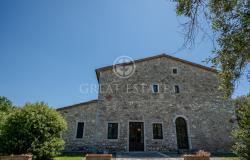 Venice's Canal Grande is poised to receive a new bridge, the fourth to span one of the most famous stretches of water in the world.
Venice's Canal Grande is poised to receive a new bridge, the fourth to span one of the most famous stretches of water in the world.
Huge iron pins to tether the structure began to be hammered home on Monday.
The bridge's underpinning is expected to be finished by February 8, engineers said.
According to Venice Mayor Massimo Cacciari, the complex construction of steel, glass and stone will be in place by early Spring.
The bridge floated up the Canal from the Venetian port of Marghera in the last two summers when tides were low enough for the newcomer to pass below the canal's three other bridges.
The pedestrian bridge, which will connect the railway station with a huge car park on the other side, has been billed as a design that draws on Venice's thousand-year history while looking towards its future.
The Venice cultural establishment has been stung by critics who claim the design by award-winning Spanish architect Santiago Calatrava is too futuristic for the city.
"Even a city so deeply marked by history should acknowledge the current era, as it has done on other occasions," said a spokesman for the city's urban planning department, Paolo De Gregori.
"This sends out a sign to the world of Venice's versatility and openness to new directions," he said.
While the overall impression of the bridge will be futuristic, Calatrava also points out that the design also incorporates a fair quantity of the locally quarried Istrian marble that dominates traditional Venetian architecture.
The bridge, composed of 74 separate segments, each one containing 55 different sized elements, will eventually form a key traffic hub for commuters and tourists.
With the construction of a tram station, it will offer a vital link between boat, tram, rail and car connections, slicing ten minutes from the journey time for those crossing from one side of the water to the other.
Nine meters wide and 9.3 meters high, the entrance on either end will be composed of a series of glass steps adorned with Istrian stone. Lights sunk into the stone will illuminate the pedestrian walkway from the ground up.
The six-million-euro design has been at the center of controversy ever since it was first unveiled in the mid-1990s.
Serious concern over its inaccessibility to wheelchairs-users - only recently resolved - long added to the row.
Calatrava allegedly refused to adjust his design to make it wheelchair-friendly on the basis it would ruin the aesthetic lines of the bridge.
But officials recently assured reporters that once "up and running" the bridge would be fully accessible to everyone, regardless of mobility problems.
Calatrava, 55, designed the 2004 Olympic Stadium in Athens and has won provisional bidding for the world's latest building high, a projected 2,000ft (600m) spire in Chicago.
He will design the new urban transit hub at the World Trade Center site in New York.
His trademark buildings include an auditorium and sealife centre in his native Valencia, and the Milwaukee Museum of Fine Arts.
Calatrava has received a cupboardful of awards and been the subject of numerous shows.
In 2004, he received the Gold Medal from the American Institute of Architects (AIA).
In 1993, the Museum of Modern Art (MOMA) in New York held a major exhibition of his work called "Structure and Expression".
In 2005, the Metropolitan Museum of Art in New York City, held an exhibition of his artistic work, entitled "Santiago Calatrava: Sculpture Into Architecture".
Exhibitions of his work have also taken place in Germany, England, Spain and Italy.
Calatrava's style has been heralded as bridging the division between structural engineering and architecture.









